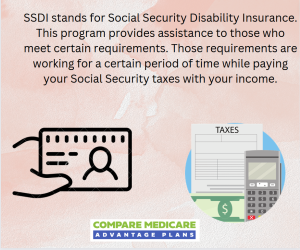Medicare Advantage Plans Disabled Under 65
Navigating the world of Medicare might be challenging, especially for disabled individuals under the age of 65. With a multitude of potential plans and options available, understanding the intricacies of Medicare Advantage will likely be crucial for those seeking comprehensive healthcare coverage.
With the right knowledge, individuals could make informed decisions and access the medical services they need while potentially maximizing their financial resources.
This article will examine the enrollment process, specialized plans, possible financial aspects, and transitioning from Social Security Disability Insurance (SSDI) to Medicare Advantage plans for disabled under 65.
By the end, members will have a better understanding of Medicare Advantage plans for disabled individuals under 65 and be better equipped to navigate their healthcare journey.
Key Takeaways
- Navigating Medicare Advantage for the Under-65 Disabled will likely require understanding eligibility criteria and comparing health insurance options.
- Selecting the right plan may involve considering the potential benefits, cost-sharing, network restrictions, and possible exclusions of each option. Special Needs Plans may also be available to meet specific needs.
- Financial assistance programs could potentially help disabled individuals under 65 manage costs while transitioning from SSDI to coverage with special enrollment periods. Maintaining coverage could be possible while working if disability meets the rules.
Compare Plans in One Step!
Enter Zip Code
Navigating Medicare Advantage for the Under-65 Disabled

Eligibility for Medicare Advantage enrollment will likely depend on the individual’s disability and their receipt of SSDI benefits. In some cases, disabled individuals under 65 may be eligible for Medicare coverage after receiving SSDI payments for 24 months.
However, there may be exceptions for certain conditions such as end-stage renal disease (ESRD) and amyotrophic lateral sclerosis (ALS), which could automatically qualify for Medicare without a waiting period.
Understanding the possible distinctions between Medicare Advantage and Original Medicare could be vital when weighing health insurance options. Medicare Advantage plans, including Medicare Advantage HMO, offered by private insurance companies, may sometimes provide extra benefits beyond the basic coverage offered by Original Medicare.
Some plans may also include prescription drug coverage and additional services like dental, vision, and hearing care. Understanding the distinctions between these possible options could help disabled individuals under 65 make informed decisions about their healthcare coverage.
Eligibility Criteria for Medicare Advantage Enrollment
Disabled individuals under 65 can qualify for Medicare Advantage after 24 months of SSDI payments. This waiting period may ensure that only those with long-term disabilities receive Medicare benefits.
However, there may be exceptions to this waiting period, such as individuals diagnosed with ESRD or ALS, may be automatically eligible for Medicare without waiting. At age 65, most people become eligible for Medicare benefits, including Medicare Advantage plans.
Upon meeting the eligibility criteria, individuals will be automatically enrolled in both Medicare Part A and Part B after the 24-month waiting period. Once enrolled, they can choose to transition to a Medicare Advantage plan that best meets their healthcare needs.
Before deciding, it’s necessary to review all plan documents comprehensively and understand the possible:
- Benefits
- Cost-sharing
- Network restrictions
- Exclusions
Comparing Health Insurance Options: Medicare Advantage vs. Original Medicare
Considering the potential benefits offered by certain Medicare Advantage plans will likely be a critical step when deciding between Medicare Advantage and Original Medicare. These plans provide coverage for Medicare Part A, Part B, and sometimes Part D prescription drug coverage, possibly eliminating the need to purchase Part D and Medicare supplement plans individually.
Furthermore, some Medicare Advantage plans may also have annual maximum out-of-pocket cost limits, possibly providing financial protection for beneficiaries.
However, some of the specific costs associated with certain Medicare Advantage plans may vary depending on the plan, location, and level of coverage desired.
Selecting the Right Medicare Advantage Plan
For disabled individuals under 65, choosing the right Medicare Advantage plan will likely be of utmost importance. Potential factors to consider may include location, plan type, and specific healthcare needs.
For instance, Special Needs Plans (SNPs) could offer tailored benefits and coverage for individuals with disabilities, possibly providing specialized care for their unique needs. The location of the beneficiary may also influence the availability, cost, and network of providers for Medicare Advantage plans.
When selecting a plan, disabled individuals should consider the following factors:
- Their specific healthcare needs related to their disability
- Access to a network of healthcare providers specializing in their condition
- Prescription drug coverage
- Additional benefits and services that could cater to their unique requirements
Understanding each plan’s possible benefits, cost-sharing, network restrictions, and potential exclusions in depth will likely be necessary for a well-informed decision.
Specialized Plans for Specific Needs

For disabled individuals under 65, Medicare Advantage could offer Special Needs Plans (SNPs) that cater to their unique requirements.
These plans could provide tailored benefits and coverage for individuals with specific chronic conditions, those eligible for both Medicare and Medicaid and those living in institutions such as nursing homes. Understanding the various types of SNPs could help individuals select the plan that best meets their healthcare needs.
SNPs will likely be classified into three main categories: Chronic Condition SNPs, Dual Eligible SNPs, and Institutional SNPs. Each of these categories has been designed to address the specific needs of disabled individuals, possibly providing specialized care and services that could offer optimal healthcare outcomes.
Chronic Condition SNPs
Chronic Condition SNPs have been designed for individuals with specific chronic conditions, possibly providing specialized care and services that could be tailored to their needs. These plans will likely cater to a range of chronic conditions, including diabetes, chronic heart failure, and chronic lung disease.
Some plans may also focus on managing the individual’s condition proactively and preventing complications.
Depending on the specific plan, level of coverage, and geographic location, the cost of Chronic Condition SNPs may vary.
Thus, it will likely be vital to review the plan details to help determine the associated costs and confirm if the plan offers the necessary coverage for the individual’s chronic condition.
Dual Eligible SNPs
Dual Eligible SNPs will likely be designed for individuals who are eligible for both Medicare and Medicaid, possibly offering comprehensive coverage and cost savings. These plans may combine multiple coverages and provide specialized care and additional services to dual-eligible beneficiaries. To qualify for Dual Eligible SNPs, individuals must meet the eligibility requirements for both Medicare and medical assistance from Medicaid.
The services that could be provided by Dual Eligible SNPs might include Medicare-covered services, supplemental benefits, prescription drug coverage, and other services that could be tailored to the needs of dual-eligible individuals.
Some plans may offer significant cost savings through coordinated care, capitated payments, and integration of Medicaid benefits.
Institutional SNPs
Institutional SNPs will likely cater to individuals who reside in a care facility, such as a nursing home, or receive nursing care in their home. These plans may be restricted to Medicare-eligible individuals who have needed institutional care for about 90 days or more. Institutional SNPs could offer:
- Specialized care and support for beneficiaries with complex medical conditions
- Greater control over quality
- Increased satisfaction among clinical staff
- Reduced administrative demands
- Improved remuneration.
Institutional SNPs may cover the cost of residing in nursing homes and provide proactive, preventive, person-centered primary care from advanced healthcare professionals.
Members should review the plan details to determine the possible costs and confirm whether the plan offers coverage suitable for the individual’s specific situation.
Financial Aspects of Medicare Advantage for the Disabled
Understanding the potential costs associated with Medicare Advantage plans for disabled individuals under 65 may be essential for making informed decisions about healthcare coverage.
These individuals might pay the same amount as seniors for Original Medicare, Medicare Advantage, and Part D plans. However, there may be financial assistance options available that could help offset the potential costs of coverage, such as Medicaid, Medicare Savings Program, and Medicare Extra Help.
Being aware of the potential expenses that may be associated with ongoing care, possible restrictions on medical care and equipment, and limited provider access may be necessary for younger Medicare beneficiaries, particularly disabled individuals under 65.
By exploring the potential financial assistance programs and carefully selecting the right Medicare Advantage plan, individuals could overcome coverage challenges and access the healthcare services they need.
Breaking Down Medicare Costs for Younger Beneficiaries

Disabled individuals under 65 may encounter high expenses for ongoing care in Medicare Advantage plans.
Some of the Part D plan costs for disabled individuals under 65 in Medicare may vary depending on the plan. However, other plan options may also vary depending on the provider. Members should review the specific details and requirements of each plan before deciding.
Assistance Programs for Medicare Expenses
Financial assistance programs that could help disabled individuals under 65 potentially offset the costs of Medicare coverage may include:
- Medicaid: a joint federal and state program that could help cover medical costs for individuals with limited income and resources. This may aid with Medicare expenses through the Medicare Savings Program.
- Medicare Savings Program: state Medicaid programs that could help pay for premiums and cost-sharing assistance for Medicare beneficiaries.
- Medicare Extra Help: a program that helps individuals with limited income and resources pay for prescription drugs.
These potential health insurance program options may provide valuable financial support for disabled Medicare beneficiaries who need assistance with their Medicare expenses.
Medicare Extra Help could be another program that might help individuals with limited income and resources pay for their Medicare prescription drug costs.
By exploring these financial assistance options, disabled individuals under 65 could manage the costs of their Medicare coverage.
Transitioning from SSDI to Medicare Advantage
 For disabled individuals under 65 transitioning from SSDI to Medicare Advantage plans, navigating the waiting period and enrollment process might pose a challenge. Medicare coverage will likely begin 24 months after receiving disability benefits (SSDI) payments.
For disabled individuals under 65 transitioning from SSDI to Medicare Advantage plans, navigating the waiting period and enrollment process might pose a challenge. Medicare coverage will likely begin 24 months after receiving disability benefits (SSDI) payments.
Once enrolled in Medicare Part A and Part B, these individuals can choose to transition to a Medicare Advantage plan that best meets their healthcare needs.
Special Enrollment Periods have a significant role in the transition process, as they allow disabled individuals under 65 to enroll in Medicare Advantage plans during designated periods.
Understanding the timing and requirements of these enrollment periods could help disabled individuals successfully transition from SSDI to Medicare Advantage and access the healthcare services they need.
The Waiting Game: SSDI to Medicare Coverage
Medicare coverage for disabled individuals under 65 will likely commence about 24 months after receiving Social Security disability benefits. This waiting period will likely ensure that only those with long-term disabilities receive Medicare benefits through their Social Security disability insurance.
However, there may be exceptions for certain conditions such as ESRD and ALS, which may be automatically eligible for Medicare without a waiting period.
During the 24-month waiting period, disabled individuals might not need to take any additional action, as coverage may automatically begin after the period has elapsed.
Once enrolled in Medicare Part A and Part B, they could choose to transition to a Medicare Advantage plan that best meets their healthcare needs.
Special Enrollment Periods: Timing Your Entry
Disabled individuals under 65 can enroll in Medicare Advantage plans during specific enrollment periods known as Special Enrollment Periods.
These periods include the Initial Enrollment Period (IEP), which begins three months before the month they become eligible for Medicare coverage due to disability.
Enrolling during the IEP guarantees that coverage commences the month after they sign up, possibly ensuring a smooth transition from SSDI to Medicare Advantage coverage.
Understanding the timing of these enrollment periods and the eligibility requirements could help disabled individuals successfully navigate the transition process and access the healthcare services they need.
Maintaining Coverage While Working

Maintaining Medicare coverage may be vital for disabled individuals under 65 who return to work. These individuals could potentially keep their Medicare benefits even after returning to work, provided their disability meets Medicare’s coverage rules.
This could allow them to continue accessing healthcare services while employed.
When a disabled individual under 65 has employer-provided health insurance coverage, Medicare will likely serve as secondary insurance.
This could mean that the employer-provided health insurance may pay for covered services first, and Medicare could cover any remaining expenses not covered by the primary insurance. By understanding the role of Medicare as secondary insurance, disabled individuals could potentially ensure they maintain access to the healthcare services they need.
Summary
This article has explored some of the complexities of Medicare Advantage plans for disabled individuals under 65.
From understanding eligibility and enrollment processes to navigating specialized plans and financial aspects, this article has provided valuable insights that could help disabled individuals make informed decisions about their healthcare coverage.
With this knowledge, disabled individuals under 65 may confidently navigate the world of Medicare Advantage and access the healthcare services they need while potentially maximizing their financial resources.
Frequently Asked Questions
→ Can you get Medicare if you are under 65 and disabled?
Yes, you can get Medicare if you are under 65 and disabled. People with disabilities who have received Social Security Disability benefits for 24 months and have End Stage Renal Disease (ESRD) or Amyotrophic Lateral Sclerosis (ALS, also known as Lou Gehrig’s disease) may qualify for the program.
However, this may not cover all medical expenses or the cost of most long-term care.
→ Is Medicare disability under 65 primary or secondary?
Medicare disability for individuals under 65 will likely be a secondary payer according to Section 1862(b)(4) of the Act and the MSP provisions of the Social Security Act if the individual is on Medicare because of a disability.
→ Can you get Medicare Part D under 65?
No, you cannot get Medicare Part D under 65, unless you are receiving Social Security Disability Insurance (SSDI) checks for at least 24 months or have been diagnosed with End-Stage Renal Disease (ESRD).
→ What is the waiting period for Medicare coverage for disabled individuals under 65?
The waiting period for Medicare coverage for disabled individuals under 65 will likely be 24 months after receiving SSDI benefits.
→ Can disabled individuals under 65 maintain their Medicare coverage when returning to work?
Yes, disabled individuals under 65 could potentially maintain their Medicare coverage when returning to work, if their disability meets the necessary criteria for coverage.

ZRN Health & Financial Services, LLC, a Texas limited liability company



